Popular categories
Looking for a yarn?
Angel Kissed
Knitted baby overall with lace pattern in DROPS BabyAlpaca Silk.
Change language:
English (UK/cm), Bulgaria- English (UK/cm), Bulgaria
- Česky - not translated
- Dansk
- Deutsch
- Eesti keel
- English (UK/cm)
- English (US/in)
- Español
- Français
- Íslenska
- Italiano
- Magyar
- Nederlands
- Norsk
- Polski
- Português
- Suomi
- Svenska
- English (UK/cm), Croatia
- English (UK/cm), Greece
- English (UK/cm), Latvia
- English (UK/cm), Lithuania
- English (UK/cm), Romania
- English (UK/cm), Slovenia
- Česky, Slovakia - not translated
Yarn group A
Size: 1/3 – 6/9 months
Size in cm: 50/56 – 62/68.
Materials:
DROPS BabyAlpaca Silk from Garnstudio
Alt. use DROPS Alpaca (100% alpaca wool) or DROPS Baby Merino (100% baby merino wool)or DROPS Safran (100% cotton)
300-300 g, white or off white
DROPS circular needle, double pointed needle and pointed needles size 2.5 mm
DROPS crochet hook size 2.5 mm
DROPS Mother of pearl buttons, no 523: 5 pcs
Silk ribbon: approx 10 mm wide - 160 cm
-------------------------------------------------------
Alternative Yarn – See how to change yarns here
Yarn Groups A to F – Use the same pattern and change the yarn here
Yarn usage using an alternative yarn – Use our yarn converter here
-------------------------------------------------------
You might also like...
Pattern instructions
Garter sts (back and forth on needle):
Knit all rows.
Moss sts:
1st row: *K1, P1*, repeat from *-*.
2nd row: K over P, P over K.
Repeat 2nd row.
Decreasing tips II (apply to mid front trousers):
Dec on each side of 2 K sts as follows:
Before 2 sts: slip 1 st as if to knit, K 1, psso.
After 2 sts: K2s tog.
OVERALL
Knit each leg separately, put them together, knit the body and finish with the sleeves.
Left leg: Cast on 32-40 sts on double pointed needles size 2.5 mm. Knit 5-6 cm moss sts. Knit 1 round in stocking sts, at the same time inc 8 sts evenly = 40-48 sts. Knit next round as follows: *K2 tog, yo*, repeat from *-*. Knit 1 round in stocking sts, at the same time inc 8 sts evenly = 48-56 sts. Now knit M.2 and continue in stocking sts. At the same time on the first round of stocking sts inc 12 sts evenly = 60-68 sts. Insert a marking thread at beg of round = inside of leg. At the same time when piece measures 11-12 cm inc 1 st on each side of MT on every 4th round a total of 6 times = 72-80 sts. When piece measures 18-21 cm split the piece by the MT and knit back and forth on needles (to make it easier to put both legs on the same circular needle to knit the body). Inc 1 st each side for seam = 74-82 sts. When piece measures 20-23 cm cast off 5 sts each side = 64-72 sts. Put the piece aside and knit right leg the same way.
Back and front piece: Put right and left leg on the same circular needle = 128-144 sts. Insert a marking thread in the transition between the legs mid front and mid back. Knit 3 rounds in stocking sts. Continue in stocking sts and now inc 1 st on each side of the 2 middle sts mid back on every other round a total of 8 times, and dec 1 st on each side of the middle 2 sts mid front on every other row a total of 8 times – see Dec tips above = 128-144 sts. When piece measures 30-40 cm cast off 8 sts mid back (= opening) and continue back and forth on needles = 120-136 sts. When piece measures 39-48 cm knit M.6 (1st row = WS and knit 1 edge st each side in garter sts). At the same time on the last row of M.6 knit tog the 2 middle sts = 119-135 sts. Knit next row as follows: 1 edge st, M.7A (= 9 sts), M.7B over 96-112 sts, M.7C (= 12 sts) and 1 edge st. At the same time when piece measures 45-54 cm knit next row as follows from the RS: K 25-29 sts (= left back piece), cast off 6 sts for armhole, 57-65 sts (= front piece), cast off 6 sts for armhole, 25-29 sts (= right back piece). Knit each piece separately.
Right back piece: = 25-29 sts. Knit M.7, at the same time dec for armhole at the side on every other row: 2 sts 1-1 time and 1 st 3-4 times = 20-23 sts. NB! Knit stocking sts over sts not fitting into pattern towards armhole. When piece measures 53-63 cm cast off the middle 5-6 sts mid back for neck and dec 1 st on neckline on every other row 2 times = 13-15 sts left on shoulder. Cast off when piece measures 55-65 cm.
Left back piece: Knit as right back piece.
Front piece: = 57-65 sts. Knit M.7, at the same time dec for armhole as described for back piece = 47-53 sts. When piece measures 51-60 cm cast off the middle 11-13 sts for neck and dec towards the neckline on every other row: 2 sts 1 time and 1 st 3 times = 13-15 sts left on each shoulder. Cast off when piece measures approx 55-65 cm – adjust to back piece.
Sleeve: Loosely cast on 68-68 sts on double pointed needles size 2.5 mm. Knit M.4 and dec 28-20 sts evenly on the last round = 40-48 sts. Knit M.2 and then finish the sleeve in M.7. At the same time when the piece measures 8 cm inc 2 sts mid under arm on every 6-9 round a total of 5-4 times = 50-56 sts – knit the inc sts in stocking sts. When piece measures 17-19 cm cast off 6 sts mid under arm and finish the piece back and forth on needle. Dec for sleeve cap on every other row: 2 sts 2-3 times, 1 st 5-3 times and then 2 sts each side until piece measures 23-25 cm. Cast off. Knit another sleeve.
Assembly: Sew the shoulder seams.
Left edge: Pick up approx 60-65 sts along left back piece on needle size 2.5 mm. Knit back and forth as follows: K 1 row from WS, knit 2.5 cm in moss sts, cast off.
Right edge: Pick up and knit as left edge, but make 5 buttonholes evenly distributed after 1 cm. 1 buttonhole = cast off 2 sts and cast on 2 new sts on next row.
Place right edge over left edge and sew at the bottom of the slit.
Lace collar: Pick up approx 55 to 65 sts from the WS round the neckline on needle size 2.5 mm (do not pick up over the edges on back piece). Knit 4 rows garter sts and 1 row in stocking sts, inc evenly to 123 sts on the stocking sts row.
Now knit M.4 – start on the 3rd row in diagram – with 2 edge sts each side in garter sts. After M.4 cast off loosely.
Crochet round the collar with hook size 2.5 mm as follows: 1 sl st in first st, *4 ch, skip 2 sts, 1 sl st in next st*, repeat from *-*.
Sew in sleeves. Sew tog between legs and under foot. Sew on buttons. Cut 2 silk ribbons measuring 20 cm each and pull through row of holes at sleeves. Cut 2 silk ribbons measuring 60 cm each and pull through the lower row of holes on each leg.
Diagram

|
= knit from RS, purl from WS |

|
= purl from RS, knit from WS |

|
= P2 tog |

|
= make a yo |

|
= K2 tog |

|
= slip 1 st as if to knit, K1, psso |

|
= slip 1 st as if to knit, K2 tog, psso |
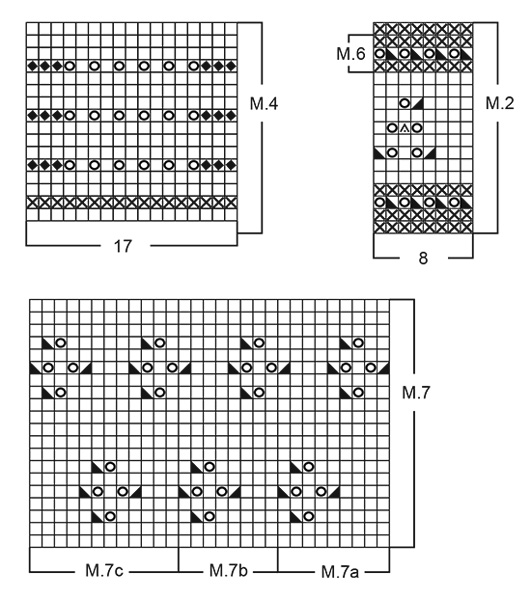
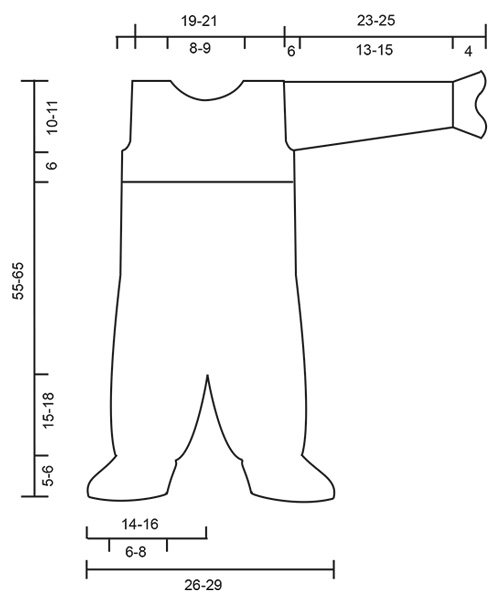
What can you do with our patterns? You can share DROPS patterns online, using the pattern original picture, materials, name and number. But you are NOT ALLOWED to reproduce the complete pattern digitally in any way. Yarn stores are welcome to use the DROPS pattern database to promote the sale of our assortment. You can print out our patterns, make as many copies as you’d like. The only thing we ask is that you don't make any changes / additions to the original printed document. And that the patterns according to the DROPS philosophy are given out to the consumers for free. Editorials that wish to publish our patterns in printed books or magazines can contact us for more information. The sale of garments based on DROPS patterns is permitted as long as they are sold as single items or per order. Further commercial use of the patterns is not permitted. It has to be clearly stated that the garment is made based on a design from DROPS DESIGN. The use of clothing labels of which DROPS DESIGN forms part is conditioned by the inclusion of the following text: “A DROPS DESIGN made by …..”. The use of DROPS photos for marketing purposes/sales is only permitted in connection with the use/sale of DROPS products. The photos may not be cut or edited and the logo should be clearly visible.
We reserve the right to withdraw the permission for use of our patterns at any time, notwithstanding the reason.
Each of our patterns has specific tutorial videos to help you.
These step-by-step tutorials might also help you:
Why is the knitting/crochet tension so important?
Knitting tension is what determines the final measurements of your work, and is usually measured per 10 x 10 cm. It is provided like so: number of stitches in width x number of rows in height - eg: 19 stitches x 26 rows = 10 x 10 cm.
The knitting tension is very individual; some people knit/crochet loosely while others work tightly. You adjust the knitting tension with the needle size, which is why the suggested needle size is only meant as a guide! You need to adjust this (up or down) to ensure that YOUR knitting tension matches the knitting tension provided in the pattern. If you work with a different knitting tension than provided you will have a different yarn consumption, and your work will have different measurements than what the pattern suggests.
The knitting tension also determines which yarns can replace each other. As long as you achieve the same knitting tension you can replace one yarn with another.
See DROPS lesson: How to measure your tension/gauge
See DROPS video: How to make a gauge tension swatch
How do I know how many balls of yarn I need?
The required amount of yarn is provided in grams, eg: 450 g. To calculate how many balls you’ll need you first need to know how many grams are in 1 ball (25g, 50g or 100g). This information is available if you click on the individual yarn quality on our pages. Divide the amount required with the amount of each ball. For example, if each ball is 50g (the most common amount), the calculation will be as follows: 450 / 50 = 9 balls.
Can I use a different yarn than what the pattern suggests?
The important thing when changing from one yarn to another is that the knitting/crochet tension remains the same. This is so that the measurements of the finished piece will be the same as on the sketch provided. It is easier to achieve the same knitting tension using yarns from the same yarn group. It is also possible to work with multiple strands of a thinner yarn to achieve the knitting tension of a thicker one. Please try our yarn converter. We recommend you to always work a test swatch.
Please NOTE: when changing yarn the garment might have a different look and feel to the garment in the photo, due to individual properties and qualities of each yarn.
See DROPS lesson: Can I use a different yarn than the one mentioned in the pattern?
What are the yarn groups?
All our yarns are categorised into yarn groups (from A to F) according to thickness and knitting tension – group A contains the thinnest yarns and group F the thickest. This makes it easier for you to find alternative yarns to our patterns, should you wish to switch yarn. All yarns within the same group have a similar knitting tension and can easily replace each other. However, different yarn qualities have different structures and properties which will give the finished work a unique look and feel.
How do I use the yarn calculator?
At the top of all our patterns you’ll find a link to our yarn calculator, which is a helpful tool should you wish to use a different yarn than suggested. By filling in the yarn quality you wish to replace, the amount (in your size) and number of strands, the calculator will present good alternative yarns with the same knitting tension. Additionally it will tell you how much you’ll require in the new qualities and whether you’ll need to work with multiple strands. Most skeins are 50g (some are 25g or 100g).
If the pattern is worked with multiple colours, every colour will have to be calculated separately. Similarly, if the pattern is worked with several strands of different yarns (for example 1 strand Alpaca and 1 strand Kid-Silk) you will have to find alternatives for each, individually.
Why do you show discontinued yarns in the patterns?
Since different yarns have different qualities and textures we have chosen to keep the original yarn in our patterns. However, you can easily find options among our available qualities by using our yarn calculator, or simply pick a yarn from the same yarn group.
It is possible that some retailers still have discontinued yarns in stock, or that someone has a few skeins at home that they would like to find patterns for.
The yarn calculator will provide both alternative yarn as well as required amount in the new quality.
What size should I knit?
If you think it's hard to decide what size to make, it can be a good idea to measure a garment you own already and like the size of. Then you can pick the size by comparing those measures with the ones available in the pattern's size chart.
You'll find the size chart at the bottom of the pattern.
See DROPS lesson: How to read size chart
Why do I get the wrong knitting tension with the suggested needle size?
The needle size provided in the pattern serves only as a guide, the important thing is to follow the knitting tension. And since knitting tension is very individual, you will have to adjust the needle size to ensure that YOUR tension is the same as in the pattern – maybe you’ll have to adjust 1, or even 2 needle sizes, up or down to achieve the correct tension. For this, we recommend that you work test swatches.
Should you work with a different knitting tension than the one provided, the measurements of the finished garment might deviate from the measurement sketch.
See DROPS lesson: How to measure your tension/gauge
See DROPS video: How to make a tension/gauge swatch
Why is the pattern worked top-down?
Working a garment top-down provides more flexibility and room for personal adjustment. For example it is easier to try the garment on while working, as well as making adjustments to length of yoke and shoulder caps.
The instructions are carefully explaining every step, in the correct order. Diagrams are adjusted to the knitting direction and are worked as usual.
How do I work according to a knitting diagram?
The diagram depicts all rows/rounds, and every stitch seen from the right side. It is read from bottom to top, from right to left. 1 square = 1 stitch.
When working back and forth, every other row is worked from the right side and every other row is worked from the wrong side. When working from the wrong side, the diagram will have to be worked reversed: from left to right, knit stitches are purled, purl stitches are knit etc.
When working in the round every round is worked from the right side and the diagram are worked from right to left on all rounds.
See DROPS lesson: How to read knitting diagrams
How do I work according to a crochet diagram?
The diagram depicts all rows/rounds, and every stitch seen from the right side. It is worked from bottom to top, from right to left.
When working back and forth every other row is worked from the right side: from right to left and every other row is worked from the wrong side: from left to right.
When working in the round, every row in the diagram are worked from the right side, from right to left.
When working a circular diagram you start in the middle and work your way outwards, counter clockwise, row by row.
The rows usually start with a given number of chain stitches (equivalent to the height of the following stitch), this will either be depicted in the diagram or explained in the pattern.
See DROPS lesson: How to read crochet diagrams
How do I work several diagrams simultaneously on the same row/round?
Instructions for working several diagrams after each other on the same row/round, will often be written like so: “work A.1, A.2, A.3 a total of 0-0-2-3-4 times". This means you work A.1 once, then A.2 is worked once, and A.3 is repeated (in width) the number of times provided for your size – in this case like so: S = 0 times, M = 0 times, L=2 times, XL= 3 times and XXL = 4 times.
The diagrams are worked as usual: begin with the first row in A.1, then work the first row in A.2 etc.
See DROPS lesson: How to read knitting diagrams
See DROPS lesson: How to read crochet diagrams
Why are the sleeves shorter in larger sizes?
The total width of the garment (from wrist-to-wrist) will be larger in the larger sizes, despite the actual sleeves being shorter. The larger sizes have longer sleeve caps and wider shoulders, so there will be a good fit in all sizes.
Where on the garment is the length measured?
The measurement sketch/schematic drawing provides information regarding the full length of the garment. If it’s a jumper or a jacket the length is measured from the highest point on the shoulder closest to the neckline, and straight down to the bottom of the garment. It is NOT measured from the tip of shoulder. Similarly, the length of yoke is measured from the highest point on the shoulder and down to where yoke is split into body and sleeves.
On a jacket measures are never taken along bands, unless specifically stated. Always measure inside band stitches when measuring the length.
See DROPS lesson: How to read a schematic drawing
What is a repeat?
Diagrams are often repeated on the round or in height. 1 repeat is the diagram the way it appears in the pattern. If it says to work 5 repeats of A.1 in the round, then you work A.1 a total of 5 times after/next to each other in the round. If it says to work 2 repeats of A.1 vertically/in height you work the entire diagram once, then begin again at the start and work the entire diagram one more time.
Why does the piece start with more chain stitches than it’s worked with?
Chain stitches are slightly narrower than other stitches and to avoid working the cast-on edge too tight, we simply chain more stitches to begin with. The stitch count will be adjusted on the following row to fit the pattern and measurement sketch.
Why increase before the rib edge when the piece is worked top-down?
The rib edge is more elastic and will contract slightly compared to, for example, stocking stitch. By increasing before the rib edge, you avoid a visible difference in width between the rib edge and the rest of the body.
Why increase in the cast-off edge?
It’s very easy to cast off too tightly, and by making yarn overs while casting off (and simultaneously casting these off) you avoid a too tight cast off edge.
See DROPS video: How to bind off with yarn overs (yo)
How do I increase/decrease on every 3rd and 4th row/round alternately?
To achieve an even increase (or decrease) you can increase on, for example: every 3rd and 4th row alternately, like so: work 2 rows and increase on the 3rd row, work 3 rows and increase on the 4th. Repeat this until the increase is complete.
See DROPS lesson: Increase or decrease 1 st on every 3rd and 4th row alternately
How can I work a jacket in the round instead of back and forth?
Should you prefer to work in the round instead of back and forth, you may of course adjust the pattern. You’ll need to add steeks mid-front (usually 5 stitches), and follow the instructions. When you would normally turn and work from the wrong side, simply work across the steek and continue in the round. At the end you’ll cut the piece open, pick up stitches to work bands, and cover the cut edges.
See DROPS video: How to knit steeks and cut open
Can I work a jumper back and forth instead of in the round?
Should you prefer to work back and forth instead of in the round, you may of course adjust the pattern so you work the pieces separately and then assemble them at the end. Divide the stitches for the body in 2, add 1 edge stitch in each side (for sewing) and work the front and back pieces separately.
See DROPS lesson: Can I adapt a pattern for circular needles into straight needles?
Why is the pattern slightly different than what I see in the photo?
Pattern repeats can vary slightly in the different sizes, in order to get the correct proportions. If you’re not working the exact same size as the garment in the photo, yours might deviate slightly. This has been carefully developed and adjusted so that the complete impression of the garment is the same in all sizes.
Make sure to follow instructions and diagrams for your size!
How do I make a women’s size garment into a men’s size one?
If you have found a pattern you like which is available in women’s size it’s not very difficult to convert it to men’s size. The biggest difference will be the length of sleeves and body. Start working on the women size that you think would fit across the chest. The additional length will be worked right before you cast off for the armhole/sleeve cap. If the pattern is worked top-down you can add the length right after the armhole or before the first decrease on sleeve.
Regarding additional yarn amount, this will depend on how much length you add, but it is better with a skein too many than too few.
How do I prevent a hairy garment from shedding?
All yarns will have excess fibres (from production) that might come off as lint or shedding. Brushed yarns (ie hairier yarns) have more of these loose, excess fibres, causing more shedding.
Shedding also depends on what is worn under or over the garment, and whether this pulls at the yarn fibres. It’s therefore not possible to guarantee that there will be no shedding
Below are some tips on how to get the best result when working with hairier yarns:
1. When the garment is finished (before you wash it) shake it vigorously so the looser hairs come off. NOTE: do NOT use a lint roller, brush or any method that pulls at the yarn.
2. Place the garment in a plastic bag and put it in your freezer - the temperature will cause the fibres to become less attached to each other, and excess fibres will come off easier.
3. Leave in the freezer for a few hours before taking it out and shaking it again.
4. Wash the garment according to the instructions on the yarn label.
Why does my garment pill?
Pilling is a natural process that happens to even the most exclusive of fibers. It's a natural sign of wear and tear that is hard to avoid, and that is most visible in high friction areas of your garment like a sweater's arms and cuffs.
You can make your garment look as new by removing the pilling, using a fabric comb or a pill/lint remover.
In the meantime, you can read the questions and answers that others have left to this pattern or join the DROPS Workshop on Facebook to get help from fellow knitters/crocheters!
Angel Kissed |
||||||||||||||||||||||
|
|
||||||||||||||||||||||
Knitted baby overall with lace pattern in DROPS BabyAlpaca Silk.
DROPS Baby 11-30 |
||||||||||||||||||||||
|
Knitting tension: 25 sts x 34 rows on needles size 2.5 mm in stocking sts = 10 x 10 cm. Note! The pattern will have more rows per 10 cm. Garter sts (back and forth on needle): Knit all rows. Moss sts: 1st row: *K1, P1*, repeat from *-*. 2nd row: K over P, P over K. Repeat 2nd row. Decreasing tips II (apply to mid front trousers): Dec on each side of 2 K sts as follows: Before 2 sts: slip 1 st as if to knit, K 1, psso. After 2 sts: K2s tog. OVERALL Knit each leg separately, put them together, knit the body and finish with the sleeves. Left leg: Cast on 32-40 sts on double pointed needles size 2.5 mm. Knit 5-6 cm moss sts. Knit 1 round in stocking sts, at the same time inc 8 sts evenly = 40-48 sts. Knit next round as follows: *K2 tog, yo*, repeat from *-*. Knit 1 round in stocking sts, at the same time inc 8 sts evenly = 48-56 sts. Now knit M.2 and continue in stocking sts. At the same time on the first round of stocking sts inc 12 sts evenly = 60-68 sts. Insert a marking thread at beg of round = inside of leg. At the same time when piece measures 11-12 cm inc 1 st on each side of MT on every 4th round a total of 6 times = 72-80 sts. When piece measures 18-21 cm split the piece by the MT and knit back and forth on needles (to make it easier to put both legs on the same circular needle to knit the body). Inc 1 st each side for seam = 74-82 sts. When piece measures 20-23 cm cast off 5 sts each side = 64-72 sts. Put the piece aside and knit right leg the same way. Back and front piece: Put right and left leg on the same circular needle = 128-144 sts. Insert a marking thread in the transition between the legs mid front and mid back. Knit 3 rounds in stocking sts. Continue in stocking sts and now inc 1 st on each side of the 2 middle sts mid back on every other round a total of 8 times, and dec 1 st on each side of the middle 2 sts mid front on every other row a total of 8 times – see Dec tips above = 128-144 sts. When piece measures 30-40 cm cast off 8 sts mid back (= opening) and continue back and forth on needles = 120-136 sts. When piece measures 39-48 cm knit M.6 (1st row = WS and knit 1 edge st each side in garter sts). At the same time on the last row of M.6 knit tog the 2 middle sts = 119-135 sts. Knit next row as follows: 1 edge st, M.7A (= 9 sts), M.7B over 96-112 sts, M.7C (= 12 sts) and 1 edge st. At the same time when piece measures 45-54 cm knit next row as follows from the RS: K 25-29 sts (= left back piece), cast off 6 sts for armhole, 57-65 sts (= front piece), cast off 6 sts for armhole, 25-29 sts (= right back piece). Knit each piece separately. Right back piece: = 25-29 sts. Knit M.7, at the same time dec for armhole at the side on every other row: 2 sts 1-1 time and 1 st 3-4 times = 20-23 sts. NB! Knit stocking sts over sts not fitting into pattern towards armhole. When piece measures 53-63 cm cast off the middle 5-6 sts mid back for neck and dec 1 st on neckline on every other row 2 times = 13-15 sts left on shoulder. Cast off when piece measures 55-65 cm. Left back piece: Knit as right back piece. Front piece: = 57-65 sts. Knit M.7, at the same time dec for armhole as described for back piece = 47-53 sts. When piece measures 51-60 cm cast off the middle 11-13 sts for neck and dec towards the neckline on every other row: 2 sts 1 time and 1 st 3 times = 13-15 sts left on each shoulder. Cast off when piece measures approx 55-65 cm – adjust to back piece. Sleeve: Loosely cast on 68-68 sts on double pointed needles size 2.5 mm. Knit M.4 and dec 28-20 sts evenly on the last round = 40-48 sts. Knit M.2 and then finish the sleeve in M.7. At the same time when the piece measures 8 cm inc 2 sts mid under arm on every 6-9 round a total of 5-4 times = 50-56 sts – knit the inc sts in stocking sts. When piece measures 17-19 cm cast off 6 sts mid under arm and finish the piece back and forth on needle. Dec for sleeve cap on every other row: 2 sts 2-3 times, 1 st 5-3 times and then 2 sts each side until piece measures 23-25 cm. Cast off. Knit another sleeve. Assembly: Sew the shoulder seams. Left edge: Pick up approx 60-65 sts along left back piece on needle size 2.5 mm. Knit back and forth as follows: K 1 row from WS, knit 2.5 cm in moss sts, cast off. Right edge: Pick up and knit as left edge, but make 5 buttonholes evenly distributed after 1 cm. 1 buttonhole = cast off 2 sts and cast on 2 new sts on next row. Place right edge over left edge and sew at the bottom of the slit. Lace collar: Pick up approx 55 to 65 sts from the WS round the neckline on needle size 2.5 mm (do not pick up over the edges on back piece). Knit 4 rows garter sts and 1 row in stocking sts, inc evenly to 123 sts on the stocking sts row. Now knit M.4 – start on the 3rd row in diagram – with 2 edge sts each side in garter sts. After M.4 cast off loosely. Crochet round the collar with hook size 2.5 mm as follows: 1 sl st in first st, *4 ch, skip 2 sts, 1 sl st in next st*, repeat from *-*. Sew in sleeves. Sew tog between legs and under foot. Sew on buttons. Cut 2 silk ribbons measuring 20 cm each and pull through row of holes at sleeves. Cut 2 silk ribbons measuring 60 cm each and pull through the lower row of holes on each leg. |
||||||||||||||||||||||
Diagram explanations |
||||||||||||||||||||||
|
||||||||||||||||||||||

|
||||||||||||||||||||||

|
||||||||||||||||||||||
|
Have you made this or any other of our designs? Tag your pictures in social media with #dropsdesign so we can see them! Do you need help with this pattern?You'll find tutorial videos, a Comments/Questions area and more by visiting the pattern on garnstudio.com. © 1982-2024 DROPS Design A/S. We reserve all rights. This document, including all its sub-sections, has copyrights. Read more about what you can do with our patterns at the bottom of each pattern on our site. |
||||||||||||||||||||||
With over 40 years in knitting and crochet design, DROPS Design offers one of the most extensive collections of free patterns on the internet - translated to 17 languages. As of today we count 309 catalogues and 11624 patterns translated into English (UK/cm). 11624
We work hard to bring you the best knitting and crochet have to offer, inspiration and advice as well as great quality yarns at incredible prices! Would you like to use our patterns for other than personal use? You can read what you are allowed to do in the Copyright text at the bottom of all our patterns. Happy crafting!









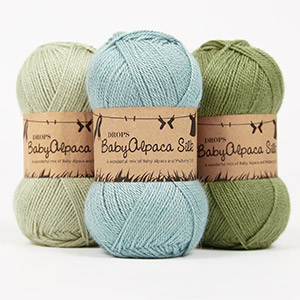




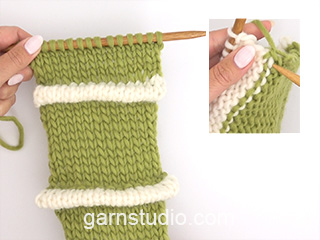
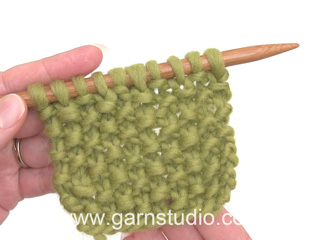
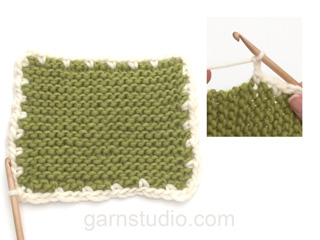
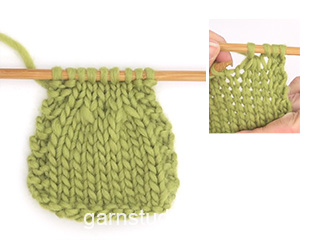

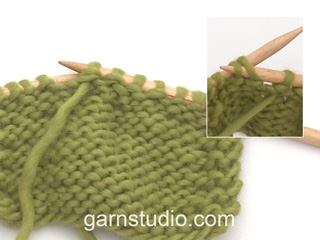
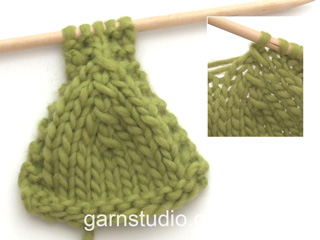
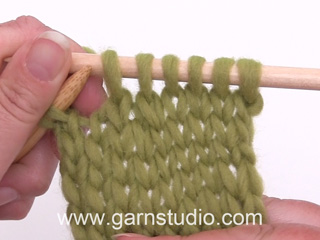


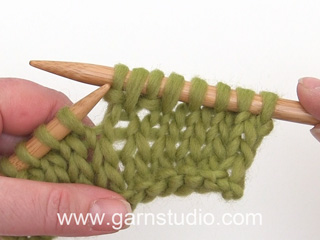
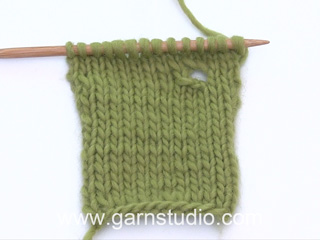
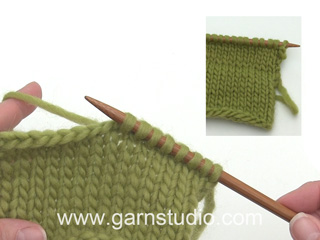

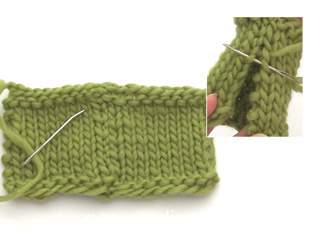
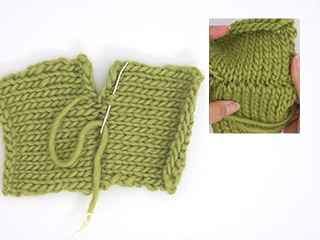
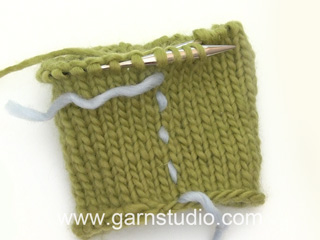
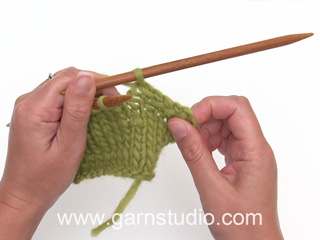
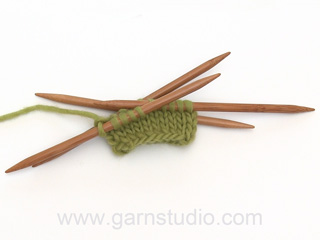
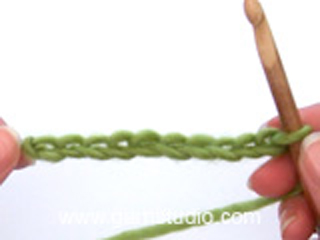
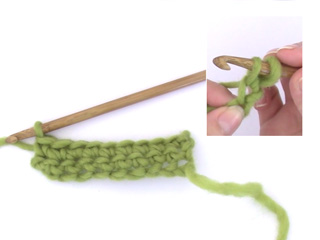
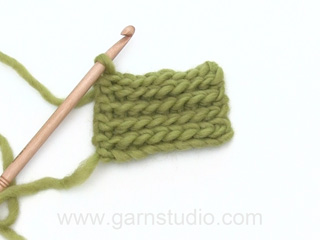
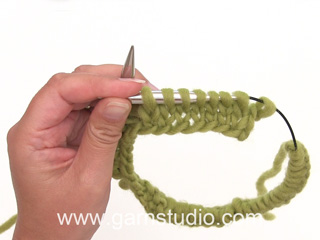

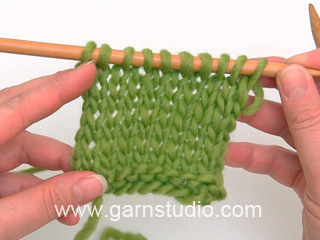

























Comments / Questions (19)
Hallo, vielen Dank für die schnelle Rückmeldung. Dann wird stets vom Anfang der Arbeit ( in diesem Fall Fuß ) gemessen. Habe ich es so richtig verstanden? Den Hinweis, ab wo gemessen wird, habe ich vermisst. Herzliche Grüße Brigitte
25.10.2024 - 16:51DROPS Design answered:
Liebe Brigitte, ja genau, das ist die gesamte Höhe, dh von der Anschlagskante, siehe auch Maßskizze; 5 cm Fuß+15 cm Bein = 20 cm insgesamt. Viel Spaß beim Stricken!
28.10.2024 - 07:45Hallo, ich habe eine Frage zu den Abmessungen. Gemäß Beschreibung sind für den Körper 30 bzw. 39 cm zu stricken bis zum Musterbeginn am Oberteil. Wenn man die Zeichnung zur Hand nimmt werden bei der kleinsten Größe für die Beine 5 + 15= 20cm, für das Oberteil 6 + 10= 16 cm, zusammen also 36 cm veranschlagt. Die Gesamtlänge ist mit 55 cm angegeben. Dann verbleiben bis zum Muster jedoch nur 19 cm. Habe ich da etwas falsch verstanden oder ist dort ggf. ein Fehler? Herzl. Grüße Brigitte
23.10.2024 - 18:09DROPS Design answered:
Liebe Brigitte, Muster beginnt nach 39 cm gesamte Länge bis 55 cm (fertige Länge) - ist so richtig, genauso wie bei der Maßskizze und Anleitung - ich missverstehe aber vielleicht Ihre Frage?
24.10.2024 - 09:15Bonjour; je n'ai pas compris dans la rubrique Dos et Devant vous dites "Placer un marqueur à la transition entre les 2 jambes au milieu devant et au milieu dos" on va mettre 1 seule marqueur au niveau de la transition entre les 2 jambe devant c ça ou on mettra 1 autre coté dos. et donc les augmentation se feront du coté de dos à 2 m du bord c'est ça merci de m'éclairer.
17.07.2023 - 15:17DROPS Design answered:
Bonjour Sima, vous plecez 2 marqueurs: premier au milieu dos et deuxieme au milieu devant. Les augmentations se fond de chaque cote de 2 mailles au milieu dos et au milieu devant (il s'agit de 2 mailles - 1 maille de chaque cote du marqueur). Bon tricot!
17.07.2023 - 23:01Hejsan! tänkte konvertera byxdräkten till en kofta istället och är osäker på var jag skall hoppa in i så fall.. kommer fortfarande att ha knapparna bak
16.12.2021 - 21:37DROPS Design answered:
Hej Lottis. Du får börja där det står "Fram- och bakstycke", men du behöver inte göra ökningar och minskningar utan sticka bara slätstickning (ev. en kant nederst om du önskar det). Sedan kan du bara sticka så långt som du vill ha koftan innan du avmaskar för öppning och mönster. Mvh DROPS Design
20.12.2021 - 10:04Los menguados de la sisa no coinciden con los menguados de la manga, Es correcto para unirlos después ?? Gracias
28.10.2021 - 13:25DROPS Design answered:
Hola Cristina, las disminuciones de la copa de la manga pueden ser diferentes a las de la sisa, pero luego cuadrarán bien.
01.11.2021 - 12:40De linker en rechter pijp moeten hetzelfde worden gebreid, maar zou ik het niet gespiegeld moeten breien?
12.09.2021 - 23:25DROPS Design answered:
Dag Zaza,
Nee, je kunt het tweede pijpje op exact dezelfde manier breien, ze zijn namelijk al symmetrisch, dus de rechter en linker kant van het pijpje is hetzelfde.
17.09.2021 - 10:38I noticed the instructions for the cast on of the collar specifies to 2.5 cm needles however this is not listed in the supplies for this pattern is this a mis type or should it be 2. 5 mm
14.11.2018 - 12:31DROPS Design answered:
Dear Veronica, you are right, it's a typo, you should use needle size 2,5 mm for the lace collar, this will be fixed, thanks. Happy knitting!
14.11.2018 - 12:43I am knitting the gown and it specifies to bind off 40 sts on each side and to work the front portion however it later says to put sts from thread back on needle to knit, so do i bind off or put on a thread? Thanks
08.11.2018 - 18:58DROPS Design answered:
Dear Veronica, the "left side" part of the pattern belongs to the front piece, ie after you have cast off the middle 2 sts for neck you continue each side of neck separately, first work the right side of neck then the left side. The 42 sts on each side of the 70 sts for front piece are bound off as explained in the pattern. Happy knitting!
09.11.2018 - 08:30I am knitting the sleeves and just finished M2 and am now moving on to M7 and notice that there are 48 sts but M7 has 29 sts. Can you indicate how to proceed ie on row 3 it reads *(K6, YO, slip as if to knit, K1, PSSO)* repeat 3 times, K5 ? Would I simply start with K6 thereby having 11 knit sts or would I just repeat K6, YO, slip as if to knit, K1, PSSO until I got to the end of the row?
01.11.2018 - 01:24DROPS Design answered:
Hi Veronica, You work just a section of M.7 on the sleeves (marked as M.7B) which consists of 8 stitches repeated on the round; Knit 5, 1 yarn over, 1 psso and knit 1. Happy knitting!
01.11.2018 - 07:54Bonjour, Combien de mailles doit-on relever pour le col dentelle de la combinaison? Merci.
20.06.2018 - 15:42DROPS Design answered:
Bonjour Émilie, on relève 55 à 65 m (le nombre de mailles a été ajouté, merci). Bon tricot!
20.06.2018 - 16:09